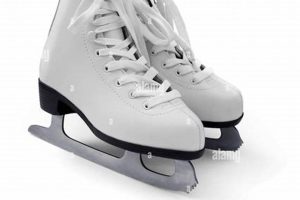Protective coverings designed to slip over the blades of figure skates after use, typically made of absorbent materials, prevent rust formation. These coverings wick away moisture, safeguarding the delicate blades from corrosion. For example, after a skating session, placing these coverings on the blades absorbs residual water, which can otherwise lead to damaging rust.
Maintaining blade integrity is crucial for optimal performance and longevity of figure skates. The use of these moisture-absorbing sheaths helps preserve the sharp edges required for precise movements on the ice. Historically, skaters have employed various methods to protect their blades, but modern absorbent coverings offer a convenient and effective solution to combat rust and maintain the quality of the equipment.
The subsequent sections will elaborate on the specific materials used in their construction, proper care and maintenance procedures, and factors to consider when selecting the appropriate type for individual skating needs.
Essential Guidance on Protective Blade Sheaths
The following recommendations are intended to maximize the protective function and extend the lifespan of these vital skating accessories.
Tip 1: Select breathable materials. Fabrics like terry cloth or synthetic blends facilitate moisture evaporation, preventing trapped humidity.
Tip 2: Ensure a proper fit. Overly tight coverings can damage blade edges, while loose coverings may fail to adequately absorb moisture.
Tip 3: Rotate between multiple sets. Alternating usage allows each set to fully dry, reducing the risk of mildew and bacterial growth.
Tip 4: Launder regularly. Periodic washing removes accumulated dirt and sweat, maintaining the absorbent properties of the material.
Tip 5: Avoid storing skates with wet coverings. Allow blades to air dry partially before applying the coverings to minimize moisture retention.
Tip 6: Inspect regularly for wear and tear. Damaged or worn coverings should be replaced promptly to ensure continued protection.
Tip 7: Consider antimicrobial options. These inhibit the growth of odor-causing bacteria, promoting hygiene and freshness.
Adhering to these guidelines will contribute significantly to preserving blade sharpness and preventing corrosion, ultimately enhancing the skating experience.
The subsequent conclusion will summarize the key benefits of utilizing these coverings and provide final recommendations for optimal skate care.
1. Absorption Capacity
Absorption capacity is a critical determinant of a blade covering’s effectiveness in preventing rust formation on figure skate blades. This characteristic directly relates to the volume of moisture the material can retain, thereby minimizing prolonged exposure of the blade to water after use. A higher absorption capacity translates to a more efficient removal of residual water from the blade’s surface, reducing the potential for oxidation. For example, coverings composed of thick terry cloth exhibit superior absorption capacity compared to thinner, less absorbent materials.
The practical significance of understanding absorption capacity extends to the lifespan of the skate blades. Blades subjected to frequent moisture exposure are prone to rust, which compromises the sharpness of the blade edge and necessitates more frequent sharpening. Sharpening reduces the blade’s thickness over time, ultimately shortening its usable life. Therefore, selecting blade coverings with high absorption capacity serves as a preventative measure, protecting the blade’s integrity and extending its longevity. Skaters who prioritize blade maintenance often invest in high-quality coverings to mitigate the risks associated with inadequate moisture absorption.
In conclusion, absorption capacity is a fundamental attribute of effective coverings. Its influence on rust prevention and blade longevity underscores the importance of considering this factor when selecting protective coverings. Overcoming challenges associated with material degradation and ensuring consistent absorbency through proper cleaning and maintenance are essential for realizing the full benefits of these protective measures. By prioritizing absorption capacity, skaters can proactively protect their equipment and maximize their performance on the ice.
2. Material Breathability
Material breathability, with regard to coverings for figure skate blades, signifies the fabric’s capacity to permit the passage of air and water vapor. This characteristic directly influences the prevention of rust by facilitating the evaporation of absorbed moisture. When the material used in a blade covering exhibits low breathability, trapped moisture creates a humid microenvironment conducive to oxidation. Conversely, breathable materials allow for efficient drying, thereby minimizing the risk of corrosion. For example, cotton terry cloth, while absorbent, can retain moisture if not adequately ventilated. Materials like microfiber, engineered for enhanced breathability, promote faster drying.
The practical application of understanding material breathability involves selecting coverings that optimize air circulation around the blade. Following skating, moisture accumulates on the blade surface due to melting ice. If this moisture remains trapped against the metal, corrosion is expedited. Breathable materials mitigate this effect by allowing the water to evaporate rather than saturate the surrounding fabric. The type of material directly affects how well residual moisture will evaporate from the blade. By enabling the easy evaporation of the moisture through proper ventilation, corrosion is prevented.
In summary, material breathability is a critical attribute of effective figure skate blade protection. It directly contributes to rust prevention by facilitating moisture evaporation. Selection of breathable materials helps mitigate the risks associated with trapped humidity and prolonged moisture exposure, thus extending the lifespan and maintaining the performance of the blades. Challenges may arise from balancing breathability with other desirable properties, such as absorption capacity and durability. However, prioritizing breathability remains essential for proper blade maintenance.
3. Rust Prevention
Rust prevention is a primary concern for figure skaters and a critical function of protective blade coverings. The corrosive nature of rust can significantly degrade blade edges, impairing performance and shortening the lifespan of the equipment. These coverings serve as a proactive defense against this degradation by managing moisture, the key catalyst for rust formation.
- Moisture Absorption
The primary function related to rust prevention is the absorption of moisture. After a skating session, residual water remains on the blade surface. Absorbent materials such as terry cloth or microfiber draw this moisture away from the blade, interrupting the oxidation process that leads to rust. Inadequate moisture absorption allows water to linger, increasing the risk of corrosion.
- Air Circulation
Effective rust prevention also relies on promoting air circulation around the blade. Even with moisture absorption, any remaining dampness can still contribute to rust if confined. Breathable materials facilitate evaporation, further reducing the potential for corrosion. This contrasts with airtight coverings that can trap moisture and exacerbate the problem.
- Material Composition
The specific material used in the blade covering plays a vital role in rust prevention. Some materials, such as untreated cotton, may retain moisture and even promote fungal growth, which can indirectly contribute to corrosion. Materials treated with antimicrobial or hydrophobic agents offer enhanced protection by inhibiting microbial activity and repelling water.
- Regular Maintenance
Effective rust prevention requires consistent maintenance of the blade coverings themselves. Over time, these coverings can accumulate dirt, sweat, and bacteria, which can compromise their absorbent properties and even introduce corrosive elements. Regular washing and drying of the coverings are essential to maintain their effectiveness in preventing rust formation.
The combined effect of these elements underscores the significance of blade coverings in rust prevention. While the specific materials and designs may vary, the underlying principle remains consistent: to minimize moisture exposure and safeguard the integrity of figure skate blades. Regular inspection, proper maintenance, and selecting appropriate coverings are all vital steps in prolonging the life and performance of figure skating equipment.
4. Blade Protection
Blade protection is paramount in maintaining the performance and longevity of figure skate blades. Protective coverings play a crucial role in mitigating damage from environmental factors and handling. The subsequent points detail facets of blade protection achievable through the use of these coverings.
- Impact Absorption
Coverings provide a degree of cushioning against accidental impacts that can occur during transportation or storage. While not designed to withstand significant force, the padding offered reduces the risk of nicks or dents to the blade edges. Damage of this nature can negatively affect a skater’s ability to execute precise maneuvers on the ice.
- Environmental Shielding
Beyond moisture management, protective coverings shield blades from dust, debris, and other abrasive particles present in the environment. These particles can accumulate on the blade surface and, over time, contribute to wear and tear, particularly if blades are not cleaned regularly. The barrier provided helps to minimize direct exposure to these contaminants.
- Edge Preservation
By preventing contact with hard surfaces, these coverings aid in preserving the delicate edges of the blades. Contact with concrete, tile, or other unforgiving materials can cause the edges to dull or chip, compromising their ability to grip the ice effectively. Maintaining sharp edges is essential for optimal performance and control during skating.
- Safe Handling
Protective coverings also enhance safety during the handling of skates. The sharp edges of figure skate blades pose a risk of cuts or scrapes if not handled with care. By encasing the blades, these coverings reduce the likelihood of accidental injury during transportation, storage, or maintenance.
The multifaceted benefits of protective blade coverings extend beyond rust prevention. They contribute to overall blade protection, ensuring that the blades remain in optimal condition for skating. Consistent use of these coverings, coupled with proper maintenance practices, can significantly prolong the life of figure skate blades and maintain a skater’s performance level.
5. Proper Fit
The efficacy of blade coverings is inextricably linked to appropriate sizing and fit. Ill-fitting coverings, whether too tight or too loose, can compromise their intended function of rust prevention and blade protection. A covering that is excessively tight may exert undue pressure on the blade edges, potentially causing damage or altering the blade’s profile. Conversely, an overly loose covering may fail to adequately absorb moisture or provide sufficient cushioning against impacts.
Real-world examples illustrate the practical significance of proper fit. A skater using a covering that is too small may find that the blade edges are constantly exposed, negating the protective benefits. This can lead to accelerated rust formation and edge dulling. Alternatively, a skater using an oversized covering may encounter issues with the covering bunching or slipping off, rendering it ineffective during transportation or storage. Selecting the correct size, based on blade length and profile, is therefore paramount.
Ensuring proper fit requires careful attention to sizing guidelines provided by manufacturers. Measurement of blade length, from toe pick to heel, is essential for determining the appropriate covering size. Consideration should also be given to the blade’s profile, as some blade designs may necessitate a larger or more contoured covering. By adhering to these principles, skaters can maximize the protective benefits of blade coverings and extend the lifespan of their equipment. Challenges may arise from variations in sizing standards across different brands, necessitating careful comparison and trial fitting when possible. However, the investment in properly fitted coverings yields long-term benefits in blade maintenance and performance.
6. Hygiene Maintenance
Hygiene maintenance is an integral consideration regarding protective blade coverings, impacting both the longevity of the coverings themselves and the overall health of skating equipment. The environment within these coverings, often damp and enclosed, can become a breeding ground for bacteria and fungi, particularly if not regularly cleaned. This proliferation can lead to unpleasant odors, material degradation, and potentially, the transfer of these microorganisms back onto the skate blades. Therefore, diligent hygiene practices are essential for minimizing these risks.
Regular cleaning of these absorbent coverings is a key aspect of hygiene maintenance. Washing removes accumulated sweat, dirt, and residual ice melt that contribute to microbial growth. The frequency of washing depends on usage intensity, but typically, washing after every few uses is advisable. Furthermore, allowing the coverings to dry completely after each use is crucial. Storing damp coverings can exacerbate microbial growth and lead to unpleasant odors. Some coverings incorporate antimicrobial treatments to inhibit the growth of bacteria and fungi. While these treatments can provide an added layer of protection, they do not eliminate the need for regular cleaning. An example highlighting practical significance is the observation that skaters who neglect hygiene maintenance often experience accelerated deterioration of their blade coverings and may notice unpleasant odors emanating from their skate bags.
In summary, hygiene maintenance is a vital component in the effective use of protective blade coverings. By regularly cleaning and drying these coverings, skaters can mitigate the risk of microbial growth, prolong the life of their equipment, and maintain a more sanitary skating environment. Challenges associated with hygiene maintenance include the time and effort required for regular cleaning, as well as the potential for material degradation from frequent washing. However, the benefits of improved hygiene far outweigh these challenges, making it an essential aspect of skate care.
7. Longevity Enhancement
Extending the usable lifespan of figure skate blades is a primary objective for skaters. Protective coverings play a significant role in achieving this goal by mitigating factors that contribute to premature wear and degradation. The following aspects outline how these coverings contribute to prolonged blade usability.
- Corrosion Mitigation
The most significant contribution to longevity enhancement is the prevention of corrosion. Rust weakens blade edges and compromises their sharpness. Coverings, by wicking away moisture, directly combat this process. Consistent use minimizes the frequency of sharpening, a process that gradually reduces blade thickness. For instance, a skater diligently using coverings might require sharpening only twice a year, while one who neglects this practice may need monthly sharpening.
- Impact Damage Reduction
Coverings provide a degree of protection against physical damage during storage and transport. Accidental impacts can cause nicks or dents in the blade edges, necessitating repair or replacement. The cushioning effect of the covering helps to absorb minor impacts, preserving the blade’s integrity. A skater transporting skates in a bag without coverings is at a higher risk of incurring such damage.
- Contamination Prevention
Abrasive particles, such as dust and grit, can accumulate on blades and contribute to wear during storage. Coverings act as a barrier, shielding the blades from these contaminants. This protection is particularly important in environments where the skates are exposed to these particles, such as in a garage or storage unit. Regular cleaning of the coverings further enhances their protective function.
- Edge Profile Preservation
Repeated sharpening alters the blade’s profile over time. By reducing the need for frequent sharpening, coverings help to maintain the original blade geometry. This is particularly important for advanced skaters who rely on specific blade profiles for executing complex maneuvers. Preserving the intended profile contributes to consistent performance and control on the ice.
The synergistic effect of these factors underscores the importance of protective coverings in longevity enhancement. While they represent a relatively small investment, their impact on the lifespan and performance of figure skate blades is substantial. Consistent use, coupled with proper maintenance, ensures that skaters can maximize the value of their equipment and enjoy consistent performance over an extended period.
Frequently Asked Questions
The following addresses common inquiries regarding the purpose, usage, and maintenance of blade protection for figure skates.
Question 1: Why are figure skate soakers necessary?
These coverings are essential for protecting skate blades from rust and corrosion. By absorbing moisture after use, they prevent oxidation, which can damage the blade’s edge and shorten its lifespan.
Question 2: What materials are best suited for figure skate soakers?
Highly absorbent and breathable materials, such as terry cloth or microfiber, are optimal. These materials effectively wick away moisture while allowing for air circulation, promoting rapid drying and preventing the buildup of humidity.
Question 3: How frequently should figure skate soakers be cleaned?
Regular cleaning is crucial for maintaining hygiene and preventing the growth of bacteria. Coverings should be washed after every few uses, or more frequently if exposed to excessive moisture or dirt. Allowing them to dry thoroughly after each use is equally important.
Question 4: Can figure skate soakers damage the blades if they are too tight?
Yes, excessively tight coverings can exert undue pressure on the blade edges, potentially causing damage or altering the blade’s profile. Ensuring a proper fit is essential for optimal protection without compromising the blade’s integrity.
Question 5: Are there any alternatives to figure skate soakers for blade protection?
While alternatives exist, such as drying blades thoroughly with a towel after each use, these methods are often less effective and more time-consuming. Protective coverings offer a convenient and reliable solution for moisture management and blade protection.
Question 6: How long do figure skate soakers typically last?
The lifespan of these coverings depends on usage frequency, material quality, and maintenance practices. With proper care, a quality set of coverings can last for several seasons. However, they should be replaced if they become worn, damaged, or lose their absorbent properties.
In summary, protective coverings are a vital accessory for figure skaters, providing essential protection against rust, corrosion, and physical damage. Proper selection, usage, and maintenance are crucial for maximizing their effectiveness and extending the lifespan of skate blades.
The subsequent section will offer concluding remarks, summarizing the key benefits and providing final recommendations for optimal skate care.
Conclusion
This examination has underscored the critical role of protective blade coverings in preserving the condition and extending the lifespan of figure skate blades. These essential accessories mitigate rust formation, protect against physical damage, and contribute to overall hygiene maintenance. Key factors such as material selection, proper fit, and consistent cleaning practices have been highlighted as integral to maximizing the effectiveness of these protective measures. The consistent use of these simple fabric coverings will make a substantial change to your figure skate.
The informed selection and diligent maintenance of figure skate soakers represent a commitment to equipment preservation and performance optimization. Investing in quality blade protection, with focused blade safety is not merely an expenditure; it is a proactive measure that yields long-term benefits. Skaters who prioritize this aspect of skate care will ultimately experience enhanced blade longevity and maintain a higher level of performance on the ice. Therefore, incorporating this protective measure into a routine is essential for all figure skaters.







